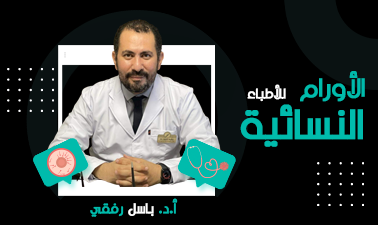
About gynecological oncology for Public course
Gynecologic oncology is a specialized field of medicine that focuses on cancers of the female reproductive system, including ovarian cancer, uterine cancer, vaginal cancer, cervical cancer, and vulvar cancer. As specialists, they have extensive training in the diagnosis and treatment of these cancers.
Gynecological cancers comprise 10-15% of women’s cancers, mainly affecting women past reproductive age but posing threats to fertility for younger patients.The most common route for treatment is combination therapy, consisting of a mix of both surgical and non-surgical interventions (radiotherapy, chemotherapy).
Through the course of gynecological oncology, we will learn about:
- Cervical cancer:
• Cervical cancer is a type of cancer that occurs in the cells of the cervix, which is the lower part of the uterus connected to the vagina.
• Different strains of human papillomavirus (HPV), a sexually transmitted infection, play a role in causing most cases of cervical cancer.
• When exposed to HPV, the body's immune system prevents the virus from causing damage. However, the virus survives for years in a small percentage of people and is involved in the transformation of some cervical cells into cancer cells.
- Early detection of the cervix: The need for Pap smear testing is currently stressed for all women between the ages of 25 and 64, as early detection contributes to the hope of recovery. According to the American Cancer Society (ACS), awareness of the need for Pap smear screening has led to a significant reduction in mortality from cervical cancer over the past few years.
- HPV vaccine: There are several types of HPV that are widespread and cause many cancers, so the HPV vaccine is the best way to prevent cervical cancer and other types of cancers caused by HPV.
Ovarian Cancer: It is a cancerous disease that forms in the ovaries. It is not yet known what the main cause of the disease is but there are factors that increase the likelihood of developing it such as family history of the disease and radiation exposure. Most of the infections occur in women aged 55-74 years. In most cases the patient does not show any symptoms and some symptoms may appear such as bleeding from the vagina, pain in the back area and disorders in the menstrual cycle. Treatment of the disease is usually done by surgery, chemotherapy, and radiotherapy.
- Borderline ovarian tumors: a noncancerous type of ovarian tumor. These tumors are described as having a low malignant ability. This means that there is little risk that the tumor will turn into cancer over time. It is believed that the behavior of the serous borderline tumor is located between a serous cystic adenoma which is a noncancerous tumor and low-grade serous cancer which is a type of cancer.
Endometrial cancer: It is a cancer that originates from the endometrium (the membrane lining the uterus), is the result of the abnormal growth of cells that have the ability to invade or spread to other parts of the body, and the initial sign is often vaginal bleeding unrelated to the menstrual period, and also includes other symptoms such as dysuria, dyspareunia or pelvic pain, and endometrial cancer is more common after menopause.
- Subtotal hysterectomy: where partial removal of the uterus removes only the uterus, leaving the cervix intact.
- Breast cancer: It is a type of cancer that appears in the breast tissue. Among its signs are a change in the shape of the breast, the appearance of a lump in the breast, peeling of the skin, fluid coming from the nipple, a newly inverted nipple, or red or scaly spots. In case of spread of the disease in the body appear the following signs: bone pain, swelling of the lymph nodes, shortness of breath or yellowing of the skin. Misuse of antibiotics: Recently, the U.S. Centers for Disease Control and the World Health Organization have acknowledged the dire consequences of overuse of antibiotics, especially after the emergence of so-called "super bacteria" resistant to modern antibiotics, causing deadly infections and diseases.
- Tumor biopsy: biopsy is a procedure for removing a piece of tissue or a sample of cells from the body to be analyzed in the laboratory. You may have a biopsy if you develop certain signs and symptoms or if your doctor finds something worrisome. A biopsy may determine you have cancer or other conditions.
- Damage caused by the division of the tumor sample: as dividing the sample into several sections and sending each part to a laboratory is a very common mistake among doctors, in this case there is a high probability that each part of the tissue contains different changes, one of the parts may be normal or has inflammation or non-cancerous problems, but the other part contains cancerous tissue, which leads to conflict and conflict between the reports of different laboratories, and this conflict distracts and distracts your doctor. The proper scientific course of action is that the complete sample is delivered to a lab, and the diagnosis is reviewed by reviewing the slats or wax blocks.
- Fertility preservation: Through the course of gynecological oncology, we will learn how to preserve fertility.
- Laparoscopic surgery: Many studies have shown that gynecological surgery using laparoscopic surgery varies according to the type of tumor and degree and we will learn through the course of gynecological tumors about the suitability of laparoscopic surgery for each type of gynecological tumor compared to traditional surgery.
Course Staff

Lecturer of Surgical Oncology and Gynecological Oncology - Mansoura University.
Specialized in Gynecological Oncology Surgery, Adult Oncology Surgery, Breast Oncology Surgery, Colon Oncology Surgery, Gynecological Oncology Surgery.
• Doctor of Surgical Oncology and Gynecological Oncology, Mansoura University Oncology Center.
• Fellowship of the Royal College of Surgeons of England.
• European Board of Oncology Surgery.
• Fellow of the National Cancer Center Tokyo, Japan.
حول دورة طب الأورام النسائية للعامة
طب الأورام النسائية هو مجال طبي متخصص يركز على سرطانات الجهاز التناسلي الأنثوي ، بما في ذلك سرطان المبيض وسرطان الرحم وسرطان المهبل وسرطان عنق الرحم وسرطان الفرج. كمتخصصين ، لديهم تدريب مكثف في تشخيص وعلاج هذه السرطانات.
تشكل السرطانات النسائية 10-15٪ من سرطانات النساء ، وهي تصيب بشكل رئيسي النساء اللائي تجاوزن سن الإنجاب ولكنها تشكل تهديداً لخصوبة المرضى الأصغر سنًا ، والطريق الأكثر شيوعًا للعلاج هو العلاج المركب ، الذي يتكون من مزيج من التدخلات الجراحية وغير الجراحية (العلاج الإشعاعي) ، العلاج الكيميائي)
من خلال دورة الأورام النسائية سوف نتعرف على:
- سرطان عنق الرحم:
• سرطان عنق الرحم هو نوع من السرطان يحدث في خلايا عنق الرحم، وهو الجزء السفلي من الرحِم المتصل بالمهبل.
• تلعب سلالات مختلفة من فيروس الورم الحليمي البشري (HPV)، والعدوى المنقولة جنسيًّا، دورًا في التسبب في معظم حالات سرطان عنق الرحم.
• عند التعرض للإصابة بـ فيروس الورم الحليمي البشري، يمنع جهاز الجسم المناعي الفيروس من إحداث الضرر. رغم ذلك ينجو الفيروس لسنوات في نسبة صغيرة من الأشخاص، ويشارك في تحول بعض خلايا عنق الرحم لخلايا سرطانية.
- الكشف المبكر عن عنق الرحم: يتم التشديد حالياً على ضرورة إجراء فحص مسحة عنق الرحم لجميع السيدات الذين تتراوح أعمارهن بين 25 و64 عاماً، حيث يسهم الكشف المبكر في تعزيز الأمل بالشفاء. ووفقاً لجمعية السرطان الأمريكية (ACS)، فقد أدت التوعية بضرورة إجراء فحص مسحة عنق الرحم إلى انخفاض معدل الوفيات الناجمة عن سرطان عنق الرحم بنسبة كبيرة خلال السنوات الأخيرة الماضية.
- لقاح فيروس الورم الحليمي البشري: هناك أنواعًا عدة من فيروس الورم الحليمي البشري واسع الانتشار، والتي تسبب العديد من السرطانات؛ لذلك يعد لقاح فيروس الورم الحليمي البشري أفضل طريقة للوقاية من سرطان عنق الرحم والأنواع الأخرى من السرطانات التي يسببها فيروس الورم الحليمي البشري.
- سرطان المبيض (Ovarian Cancer):هو مرض سرطاني يتكوّن في المبايض. لا يعرف ما هو المسبب الرئيسي للمرض حتى الآن ولكن توجد عوامل تؤدي إلى زيادة احتمالية الإصابة به مثل التاريخ العائلي للمرض والتعرض للإشعاع. معظم الإصابات تحدث لنساء تتراوح أعمارهم ما بين 55-74 عاما. في معظم الحالات لا تظهر أيّة أعراض على المريضة وقد تظهر بعض أعراض مثل النزيف من المهبل، آلام في منطقة الظهر واضطرابات في الدورة الشهرية. يتم علاج المرض عادة عن طريق الجراحة والعلاج الكيميائي والعلاج بالأشعة.
- أورام المبيض الحدية: وهو نوع غير سرطاني من أورام المبيض. توصف هذه الأورام بأنها ذات قدرة خبيثة منخفضة. هذا يعني أن هناك خطرًا ضئيلًا من أن يتحول الورم إلى سرطان بمرور الوقت. يُعتقد أن سلوك الورم الحدودي المصلي يقع بين أ ورم غدي كيسي مصلي وهو ورم غير سرطاني و سرطان مصلي منخفض الدرجة وهو نوع من السرطان.
- سرطان بطانة الرحم: هو سرطان ينشأ من بطانة الرحم) الغشاء المبطن للرحم(، يكون نتيجة للنمو غير الطبيعي للخلايا التي لديها القدرة على الغزو أو الانتشار إلى أجزاء أخرى من الجسم، وتكون العلامة الأولية غالبًا نزيف مهبلي غير مرتبط بفترة الحيض، كما يشمل أعراض أخرى مثل عسر التبول أو عسر الجماع أو ألم الحوض، ويكون سرطان بطانة الرحم أكثر شيوعًا بعد انقطاع الطمث.
- استئصال الرحم الجزئي: حيث يزيل الإستئصال الجزئي للرحم الرحم فقط، ويترك عنق الرحم سليمًا. - سرطان الثدي: هو نوع من أنواع السرطان يظهر في أنسجة الثدي. من علاماته تغير في شكل الثدي، وظهور كتلة في الثدي، تقشير الجلد، سائل قادم من الحلمة، حلمة مقلوبة حديثًا، أو بقع حمراء أو متقشرة. في حالة انتشار المرض في الجسم تظهر العلامات التالية:آلام العظم، انتفاخ في الغدد الليمفاوية، ضيق في التنفس أو اصفرار في الجلد.
- إلإفراط في استخدام المضادات الحيوية: ففي الآونة الأخيرة، أقرت المراكز الأميركية لمكافحة الأمراض ومنظمة الصحة العالمية العواقب الوخيمة للإفراط في استخدام المضادات الحيوية، خصوصاً بعد ظهور ما يسمى بـ«السوبر بكتيريا»، المقاومة للمضادات الحيوية الحديثة، مسببة التهابات وأمراضاً قاتلة.
- أخذ عينة الورم: أخذ العينة هي إجراء لإزالة قطعة من النسيج أو عينة من الخلايا من الجسم من أجل تحليلها في المختبر. قد تخضع لإجراء الخزعة، إذا ظهرت عليك علامات وأعراض معينة أو إذا اكتشف طبيبك أمرًا مثيرًا للقلق. قد تحدد الخزعة إصابتك بالسرطان أو غيره من الحالات.
- الأضرار المترتبة على تقسيم عينة الورم: حيث أن تقسيم العينة لعدة أقسام وإرسال كل جزء لمعمل يعتبر من الأخطاء الشائعة جداً بين الأطباء، وفي هذه الحالة هناك احتمالية كبيرة أن يحتوي كل جزء من النسيج على تغيرات مختلفة، فقد يكون أحد الأجزاء طبيعياً أو به التهاب أو مشكلات غير سرطانية، ولكن الجزء الآخر يحتوي على نسيج سرطاني، مما يؤدي لتضارب وتعارض بين تقارير المعامل المختلفة، وهذا التضارب يشتتك ويشتت طبيبك، والتصرف العلمي السليم هو أن يتم تسليم العينة كاملة لأحد المعامل، وتتم مراجعة التشخيص عن طريق مراجعة الشرائح أو البلوكات الشمعية.
- الحفاظ على الخصوبة: سوف نتعرف من خلال دورة الأورام النسائية على كيفية الحفاظ على الخصوبة. - الجراحة بالمنظار: وقد أظهرت العديد من الدراسات أن الجراحة النسائية باستخدام المنظار تختلف مدى ملائمتها بحسب نوع الورم ودرجة وسوف نتعرف من خلال دورة الأورام النسائية على ملائمة جراحة المنظار لكل نوع من أنواع الأورام النسائية مقارنة بالجراحة التقليدية.
تحت اشراف فريق عمل منصة معارفالمحاضر

أ.د. باسل رفقي
مدرس جراحة الأورام وأورام النساء - جامعة المنصورة.
متخصص في جراحة الأورام النسائية، جراحة أورام بالغين، جراحة أورام الثدي و جراحة أورام القولون، جراحة أورام القولون، جراحة أورام نسائية.
• دكتوراه جراحة الأورام وأورام النساء مركز الأورام جامعة المنصورة.
• زمالة الكلية الملكية للجراحين إنجلترا.
• البورد الأوروبى لجراحة الأورام.
• زميل المركز الوطني للأورام طوكيو اليابان.

